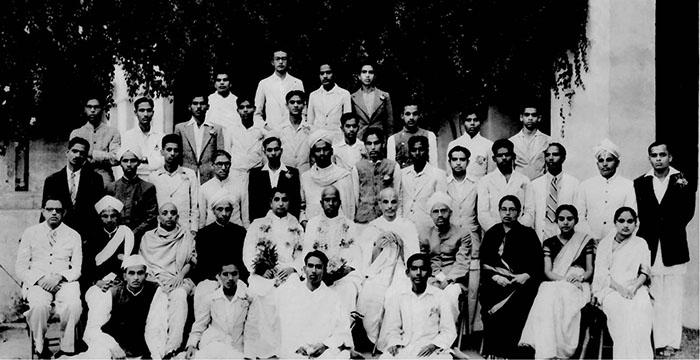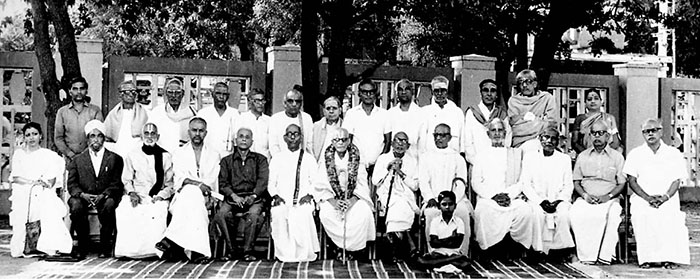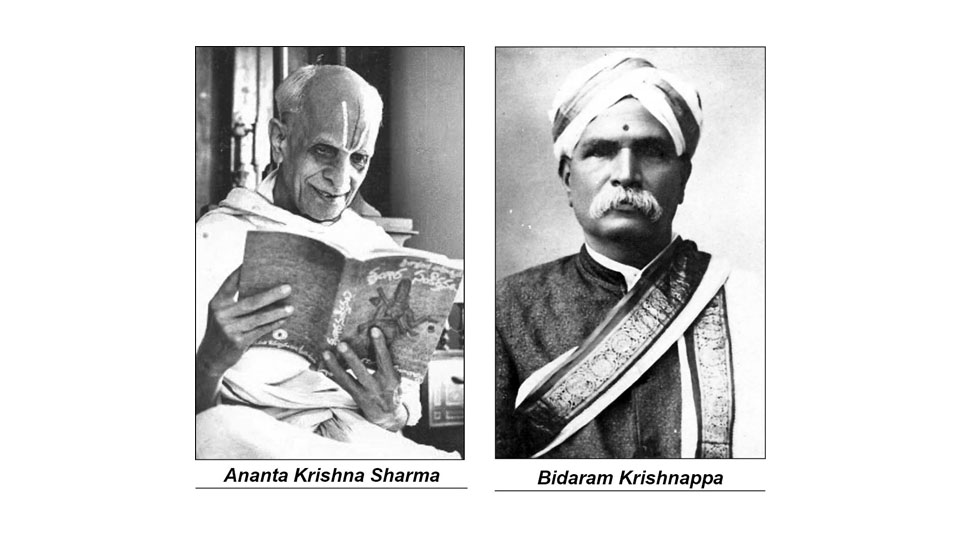By Dr. Bhagirath S. Naganath
[Continued from June 11]
Rallapalli Ananta Krishna Sharma was 14 years of age when he composed his first Sanskrit composition. It was devoted to Goddess Lakshmi titled ‘Jalarashi Balelole.’ A compilation of his Sanskrit writings was published under the title of ‘Anantha Bharathi’ and had compositions like Sri Mahishura Rajyabhyudaya Darshala, Sri Gita Govinda Patha Parikshanam, Valmikehe Geye Parispandaha and Nyasa Kalanidhiutsava. ‘Sri Mahishura Rajyabhyudaya Darshala’ won Sharma the first prize, among forty contestants in a poetry competition held in Mysore to commemorate the achievements of the Maharaja in 1925. It was set in Champu Kavya.
While Sharma translated many more works, he abandoned quite a few on the premise that they were not of sufficiently high standard ! For many that he did retain, he had difficulty publishing them owing to financial constraints. On more than one occasion, C.R. Reddy offered to fund the publications of these translations. Reddy even authored a preface to one of Sharma’s seminal works in 1931. Rallapalli Ananta Krishna Sharma assumed editorial responsibilities of Tirupati Oriental Research Institute in 1950 and was also a research scholar there till 1958. His ‘Gaanakale’ was written at the insistence of V. Seetharamaiah & Koodali Chidambaram and attracted considerable scholarly attention. D.V. Gundappa wrote a complimentary review on this in ‘Janapragati.’ This was reprinted in 1973. Sharma also gave several talks on All India Radio (AIR) on a host of topics related to music and history of music.

As a Vocalist
Rallapalli Ananta Krishna Sharma listened to music by Karigiri Raya, Chikkaramaraya, Veena Sheshanna, Subbanna, Mysore Vasudevacharya and Muthiah Bhagavatar. Sharma often limited himself to singing in private platforms. His guru Bidaram Krishnappa felt that, as Sharma was equally proficient both in the study of Shastras as well as in singing of the compositions, it would be better to leave the field for those who sang for a livelihood. Sharma could limit himself to teaching these Shastras and Sanskrit compositions rather than singing them as a vocation. This promise made by Sharma to his teacher was one of the reasons that he seldom agreed to sing in public gatherings, especially for remuneration! Many years later, when Muthiah Bhagavatar informed Sharma that he had arranged a private concert with the Maharaja, Sharma at once politely declined and excused himself! However, many of Sharma’s close acquaintances like N.S. Subba Rao would often visit him at his house and listen to him privately. Sharma would also arrange private bhajans and concerts at his residence where he invited close aides like V. Seetharamaiah, B. Venkataramaiah and R.K. Pattabhiraman.
Some of his personal favourites were ‘Harini Hariramani’ and ‘Amba Vishalamba.’ Privately, Sharma had some reservations regarding Kalidasa’s compositions, especially with regard to his use of metre & scale and the arduous task of adapting them to singing. Rallapalli Ananta Krishna Sharma was responsible for bringing back many of Vemana’s compositions into vogue. Similarly, he was also instrumental in popularising many of Kshetrayya’s compositions as well. In addition to popularising Vemana and Kshetrayya’s compositions, he succeeded in bringing to life the compositions of Tallapaka Annamacharya and his son Pedda Tirumalecharya. In fact, later singers like M.S. Subbalakshmi and Balamurali Krishna sang many of Annamacharya’s compositions only after they were popularised initially by Ananta Krishna Sharma. When TTD Trust (Tirupathi) began retrieving songs of Annamacharya that had been stored on copper plates from the temple lockers, it was Sharma who was at the forefront in deciphering these into legible text and eventually cataloguing them.
Sharma was quite badly affected by the Influenza pandemic in 1918. He was advised by doctors to give up singing and instead take up instrumental music. Sharma had a keen ear for music. Once a passing beggar was heard singing ‘Nadasudharasambhilanu’ in ‘arabhi’ raga. Sharma at once ran out and invited the beggar to come in and sing the entire rendition for him. Sharma learnt this rare piece from the passing beggar and practised it over and over again. Sharma then shared it with Muthiah Bhagavatar who liked it so much that, he in turn taught the same to many of his students. Among the many vocalists whom he influenced and taught, some deserve special mention here — A.V. Krishnachar, T.S. Thathachar, B. Ramachar (Kurnool), B. Lakshminarasimhachar (Hospet), B. Venkataramayya, Phanishayi (his son), Sarojamma, Sripada Pinakapani and Sandhyavandhanam Srinivasa Rao.
Rallapalli’s vast repertoire of Telugu poetry and literature was very well-known in academic circles. Kattamanchi Ramalinga Reddy from the Philosophy and English Department was already a fan of Sharma’s poetry. Reddy used his influence with the University to create a lecturer’s post for Sharma. Rallappalli served the University for 38 years as a Telugu teacher from 1910 till 1949 when he retired. The University failed to sanction Sharma with a pension, in spite of sustained efforts by many of his colleagues. When T.V. Venkatachala Sastry later lamented about this travesty, Sharma retorted back that his plight was of no significance when compared to the difficulty M. Hiriyanna was put through when he was supposed to get his pension!
The University of Mysore started MA in Kannada in 1927. It was mandatory to select a second language. Most used to select Tamil. Following Sharma’s appointment, there was an upsurge in the number of students taking up Telugu as their second language. Some of his prominent students include K.V. Puttappa, G.P. Raja Ratnam, D.L. Narasimhachar, M.V. Seetharamaiah, T.S. Shama Rao, B. Kuppuswami, G.S. Shivarudrappa and M.S. Venkata Rao. One of Sharma’s favourite texts to teach was ‘Tikannana Udyogaparva’. Sharma’s colleagues always knew that he was the last resort in resolving doubts about musicology and Telugu literature when reliable information could not be sourced elsewhere.
Sharma married Rukminiamma when he was 18 years of age.
At Sarvepalli Radhakrishnan’s farewell function, Sharma composed a few lines in Radhakrishnan’s honour and read them out. Radhakrishnan was greatly impressed on hearing these impromptu compositions. But one of Sharma’s colleagues stood up and remarked that all the lines were in anushtab chandass (metre). Sharma took a moment and replied that if anushtab chandass was good enough for Valmiki, why should it not be good enough for the rest of us!

Recognition
Sharma’s essay on the progress of Mysore State titled ‘Sri Mahisura Rajyabhyudayadarsha’ won him the first prize. The achievements of both Nalwadi Krishnaraja Wadiyar and Chamaraja Wadiyar were listed here in poetic metre.
When Rabindranath Tagore visited Mysore in 1917 and sang ‘Devi Bhuvanamanamohini,’ Sharma internalised it and in rhythmic metre sang it back! Tagore was taken aback and appreciated it greatly.
At C.R. Reddy’s behest, Sharma gave a lecture on Vemana in several parts of Andhra Pradesh. He had endeavoured for many years to collect historical information on Vemana. Sadly, his success was limited, as was his predecessors.’ Sharma was single-handedly responsible for bringing back many of Vemana’s renditions into popular culture. This inspired Siddavanahalli Krishnasharma, D.R. Venkataramana and T.S. Shama Rao to translate these from Telugu to Kannada.
Rallapalli Ananta Krishna Sharma presided over the Sangeeta Sammelana in Mysore in 1927. At this meet, Sharma’s lecture was scheduled to be delivered at noon. But many preceding events took a greater share of time and Sharma was able to talk only at 1 pm. Considering that lunch was scheduled at 1.30 pm, the organisers rather bluntly requested Sharma to keep his address brief. Sharma did not take any offense and began to talk. Exactly after twenty minutes, Sharma paused and looked around. There was pin-drop silence. The entire audience was spell-bound and almost in a trance listening to his mellifluous voice. When Sharma continued his pause, Nageshwara Rao Panthulu stood up and rather assertively requested Sharma to continue talking and added that his words were enough fodder for their hunger. The audience joined in and requested Sharma to continue as well. This Presidential address lasted 2.5 hrs! It was laced with such erudition and profound scholarship that his address was printed verbatim by ‘Andhra Patrike’, ‘Bharathi’ and other newspapers. The organisers later tendered an apology for their rude behaviour!
Sharma was honoured with the ‘Gana Kala Sindhu’ in 1961 and the ‘Gana Kala Prapoorna’ in 1969. Bangalore Gayana Samaja bestowed on Sharma the ‘Sangeeta Kala Ratna’ in 1970. Sharma received the Central Sangeet & Natak Academy Fellowship in 1973. The Madras Music Academy awarded Sharma the ‘Sangeeta Kalanidhi’ honour in 1974. Rallapalli Ananta Krishna Sharma was conferred with an Honorary Doctorate by Tirupati Sri Venkateshwara University in 1974. The Jayanagar Cultural Society, Bangalore, also conferred on him a Lifetime Achievement Award for his lifelong contribution to the world of music and shastras. The TTD Trust conferred on Sharma the prestigious ‘Sangeeta Sahitya Asthan Vidwan’ honour. The representative from the Trust reached Sharma’s residence around 4 pm in the afternoon and presented the honour. A few hours later, around 7.15 pm, Sharma breathed his last on 30th April 1974.
Rallapalli Ananta Krishna Sharma was a bridge between two States and two languages. He was also a walking repository of centuries of Karnatak musical tradition and forgotten compositions by various saints and scholars. If not for his perseverance, many of these compositions would have been lost in the sands of time. Above all else, Sharma was the perfect bridge between the world of Shastras and the world of Sangeetha. Let us remember him with much gratitude and nostalgia on his death anniversary (April 30) every year. The world of Karnatak music is enriched by him forever!
[References: 1. Deevatigegalu by Dr. S.R. Ramaswamy (1998); 2. Official Website of Rallapalli Ananta Krishna Sharma maintained by his children].








Interesting biographical vistas of this multi-facted scholar, Rallapalli Ananta Krishna Sharma Mysore with its rich traditions made him what he was- an erudite human being.
What is troubling with this 2 set of narratives is this: 1.There is a confusing mix of chronology, with repeated descriptions of the life and achievements of this great Sanskrit scholar, vocalist and instrumentalist-particularly a superb violinist. The SOM editor Vikram should have ensured that there is an order in these narratives, the best order is through periods, starting from the childhood in stages of his life, not deviating from it, going backwards and forwards, which defeats the very purpose of such narratives about a great scholar 2. The strict chrnological order means, it easier to lkist those disciples who he taught vocal music or violin. Wile one could easily gather:A.V. Krishnachar, T.S. Thathachar, B. Ramachar (Kurnool), B. Lakshminarasimhachar (Hospet), B. Venkataramayya, Phanishayi (his son), Sarojamma as his discipoles, where as Sripada Pinakapani and Sandhyavandhanam Srinivasa Rao presumably were influenced by him, in what ways? I have a personal interest here. My close friend in Mysore was related to T.S. Thathachar, who I had met a few times.
There is a serious error in regards to the date of his demise. Rhis author says: “The representative from the Trust reached Sharma’s residence around 4 pm in the afternoon and presented the honour. A few hours later, around 7.15 pm, Sharma breathed his last on 30th April 1974”, where as the Wikipedia says he died on: 11 March 1979, Bengaluru. i read in December 1974, in the Hindu, his award of ‘Sangeeta Kalanidhi’, with Rallapalli present in the Madras Music Academy to receive this award in person in December 1974; this award is given to the musician named earlier in the year, during the Madras Music Academy, during its Winter Session in December, always, since from 1929. I clearly remember the achievements of Rallapalli, then read in his presence at that time in 1974, as reported in the Hindu. So, Rallapalli,was alive in December 1974!
Besides this significant error, the author should have clearly stated that the Trust representative presented this honour in Bangalore.
I find similar issues, pariticularly the narratives by this author in respect of personalities, presented in a disorderely way, which through revisions could have been straightened out. Vikram , please note.
I should have also added that this article should have emphasised well, in more detail, the part played by the Parakala Mutt of its patronage of scholars like Ralaalpalli Ananthakrishna Sharma. He was immensely helped from the patronage of this Mutt.. Though of Advaita tradition follower, I have had personal experience of this Mutt ensuring the development of many Sanskrit and Vedic scholars,right from their young age, by providing accommodation and meals, and recognising their achievements when it was necessary. This Mutt’s history is worth elaborating as the centre of culture in Mysore.
Mention of Parakala Mutt; it was able to support many poor students who studied Sanskrit and Vedas, and who were of SriVaishnava tradition, amnd was able tp proviode patronage to scholats like Rallapalli AnanthaKrishna Sharma, by providing financial hlep for those students who wanted to learn music under him/
Parakala Mutt had in those days, vast support of Santhepet Merchants who were followers of this Mutt, and hence would step in should financial assistance was needed.
The other detail is, Maharaja’s College in those days would employ traditionally trained schoalrs, without the MA degree requirment, to supplant teaching in subjects like Sanskrit and Telugu. as lecturers.allapalli AnanthaKrishna Sharma was one of them.
Mention of Parakala Mutt; it was able to support many poor students who studied Sanskrit and Vedas, and who were of SriVaishnava tradition, amnd was able tp proviode patronage to scholats like Rallapalli AnanthaKrishna Sharma, by providing financial hlep for those students who wanted to learn music under him/
Parakala Mutt had in those days, vast support of Santhepet Merchants who were followers of this Mutt, and hence would step in should financial assistance was needed.
The other detail is, Maharaja’s College in those days would employ traditionally trained schoalrs, without the MA degree requirment, to supplant teaching in subjects like Sanskrit and Telugu. as lecturers.allapalli AnanthaKrishna Sharma was one of them.